Thermaltake Toughpower DPS G RGB 850W PSU Review
In addition to its flagship Titanium line, Thermaltake also equipped the DPS G Gold family with an RGB fan. The highest-capacity model outputting up to 850W is our test subject today.
Why you can trust Tom's Hardware
Load Regulation, Hold-Up Time, And Inrush Current
To learn more about our PSU tests and methodology, please check out How We Test Power Supply Units.
Primary Rails And 5VSB Load Regulation
Load Regulation testing is detailed here.


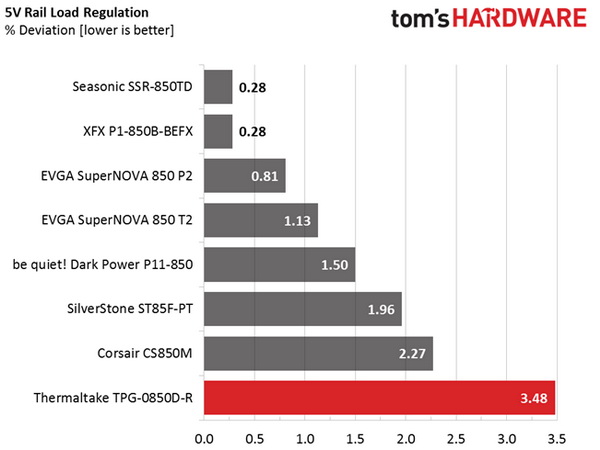





Hold-Up Time
Our hold-up time tests are described in detail here.
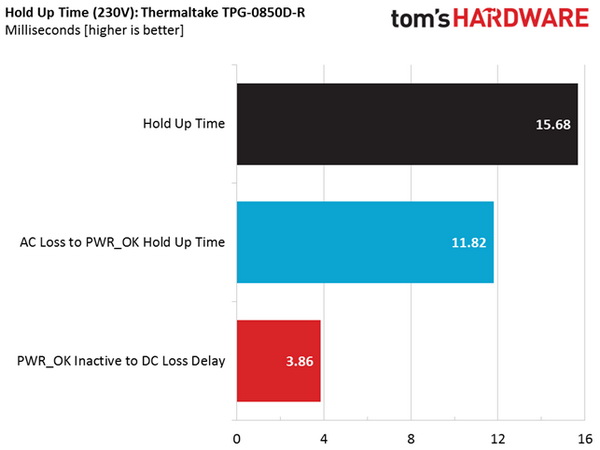






The hold-up time is a little lower than required, while the power-good signal's time is significantly lower than the ATX specification's minimum. At least that signal is accurate, since it drops before the rails go out of spec.
Inrush Current
For details on our inrush current testing, please click here.

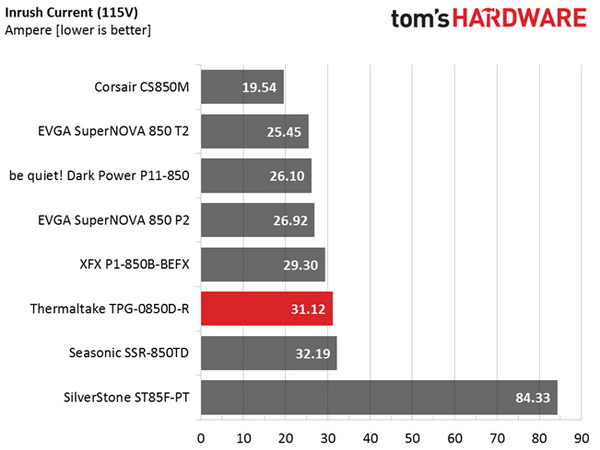
The inrush current levels are normal with both voltage inputs (115V and 230V).
Load Regulation And Efficiency Measurements
The first set of tests reveals the stability of the voltage rails and the TPG-0850D-R's efficiency. The applied load equals (approximately) 10 to 110 percent of the PSU's maximum load in increments of 10 percentage points.
Get Tom's Hardware's best news and in-depth reviews, straight to your inbox.
We conducted two additional tests. During the first, we stressed the two minor rails (5V and 3.3V) with a high load, while the load at +12V was only 0.1A. This test reveals whether a PSU is Haswell-ready or not. In the second test, we determined the maximum load the +12V rail could handle with minimal load on the minor rails.
| Test # | 12V | 5V | 3.3V | 5VSB | DC/AC (Watts) | Efficiency | Fan Speed | Fan Noise | Temps (In/Out) | PF/AC Volts |
|---|---|---|---|---|---|---|---|---|---|---|
| 1 | 5.216A | 1.983A | 1.979A | 0.996A | 84.78 | 86.71% | 0 RPM | 0 dB(A) | 50.86°C | 0.975 |
| 12.114V | 5.042V | 3.333V | 5.017V | 97.78 | 39.68°C | 115.1V | ||||
| 2 | 11.480A | 2.979A | 2.981A | 1.201A | 169.65 | 90.09% | 0 RPM | 0 dB(A) | 51.83°C | 0.990 |
| 12.090V | 5.023V | 3.318V | 4.995V | 188.31 | 40.02°C | 115.1V | ||||
| 3 | 18.129A | 3.497A | 3.505A | 1.405A | 254.86 | 90.78% | 536 RPM | 22.4 dB(A) | 42.21°C | 0.994 |
| 12.067V | 5.009V | 3.307V | 4.977V | 280.74 | 53.53°C | 115.1V | ||||
| 4 | 24.790A | 4.005A | 4.005A | 1.610A | 339.70 | 90.82% | 536 RPM | 22.4 dB(A) | 42.51°C | 0.996 |
| 12.042V | 4.994V | 3.294V | 4.960V | 374.03 | 54.37°C | 115.1V | ||||
| 5 | 31.104A | 5.021A | 5.029A | 1.821A | 424.58 | 90.48% | 536 RPM | 22.4 dB(A) | 42.90°C | 0.997 |
| 12.028V | 4.973V | 3.280V | 4.939V | 469.28 | 57.39°C | 115.1V | ||||
| 6 | 37.106A | 6.055A | 6.060A | 2.030A | 509.50 | 89.83% | 544 RPM | 22.5 dB(A) | 44.23°C | 0.997 |
| 12.120V | 4.954V | 3.267V | 4.917V | 567.17 | 61.63°C | 115.1V | ||||
| 7 | 43.408A | 7.093A | 7.105A | 2.245A | 594.44 | 88.99% | 804 RPM | 29.6 dB(A) | 44.70°C | 0.998 |
| 12.103V | 4.933V | 3.251V | 4.894V | 667.97 | 63.64°C | 115.1V | ||||
| 8 | 49.753A | 8.148A | 8.157A | 2.460A | 679.38 | 88.28% | 804 RPM | 29.6 dB(A) | 46.39°C | 0.998 |
| 12.079V | 4.913V | 3.236V | 4.873V | 769.58 | 66.71°C | 115.1V | ||||
| 9 | 56.560A | 8.680A | 8.719A | 2.464A | 764.43 | 87.54% | 884 RPM | 30.0 dB(A) | 46.50°C | 0.998 |
| 12.055V | 4.899V | 3.223V | 4.861V | 873.28 | 67.42°C | 115.1V | ||||
| 10 | 63.127A | 9.220A | 9.252A | 3.106A | 849.18 | 86.47% | 1084 RPM | 35.8 dB(A) | 47.42°C | 0.998 |
| 12.031V | 4.882V | 3.210V | 4.826V | 982.08 | 68.61°C | 115.1V | ||||
| 11 | 69.480A | 9.242A | 9.276A | 3.113A | 924.10 | 85.64% | 1324 RPM | 40.9 dB(A) | 47.89°C | 0.998 |
| 12.009V | 4.871V | 3.202V | 4.816V | 1079.07 | 69.42°C | 115.1V | ||||
| CL1 | 0.099A | 16.025A | 16.004A | 0.004A | 132.15 | 81.94% | 536 RPM | 22.4 dB(A) | 44.00°C | 0.988 |
| 12.100V | 4.910V | 3.265V | 4.991V | 161.28 | 64.33°C | 115.1V | ||||
| CL2 | 70.789A | 1.003A | 1.003A | 1.002A | 864.34 | 86.92% | 1172 RPM | 38.5 dB(A) | 48.93°C | 0.998 |
| 12.024V | 4.957V | 3.248V | 4.933V | 994.40 | 71.04°C | 115.1V |
The load regulation on the +12V rail is pretty tight. In comparison, the minor rails—including 5VSB— have loose regulation, which falls outside of the 3% region. It is worth mentioning that the +12V rail has a strange voltage increase in the 60% load test, something that we rarely see in our tests. The resonant controller appears to perform this change in order to keep regulation in order, and the trick keeps the rail within 1%, achieving good overall performance.
Up to the 20% load test, Thermaltake's TPG-0850D-R operates in passive mode. It's only during a very stressful scenario that includes full load delivery under a high ambient temperature that the fan's speed increases enough to make a noticeable noise. The 40 dB(A) mark is exceeded during the overload test, where the PSU is pushed beyond its official limits. In general, the fan profile is very loose and offers quiet operation.
When it comes to efficiency, Thermaltake narrowly misses the 87% mark during our 20% load test, while with mid-load it is over the desired 90%. However, under full load it scores less than 87% efficiency. In a normal environment this PSU should have no trouble meeting the 80 PLUS Gold requirements, though we've seen Gold-rated units register much higher efficiency levels.
DPSApp Screenshots
You will find several screenshots of the DPSApp software below.










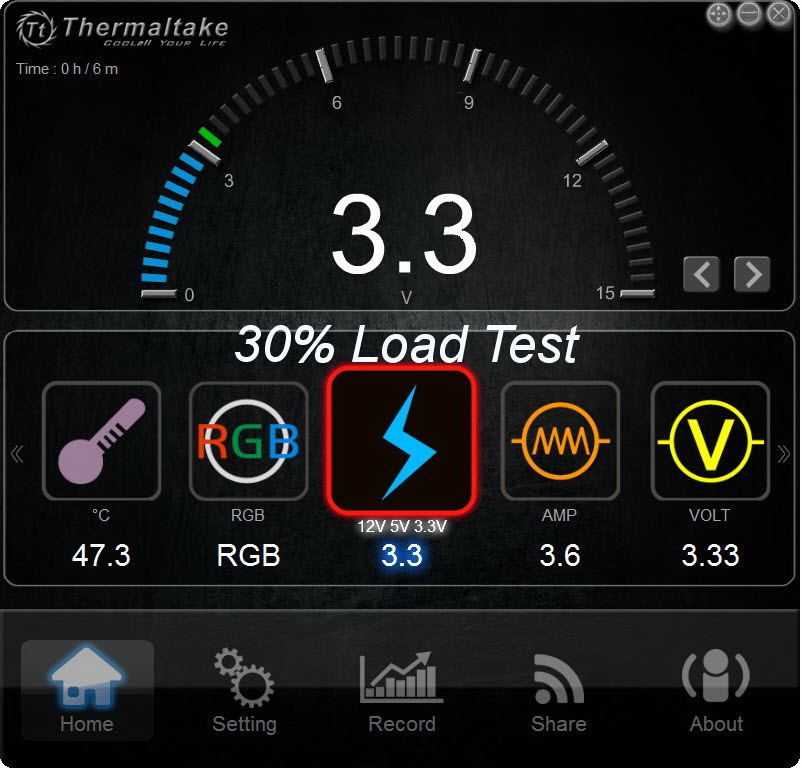





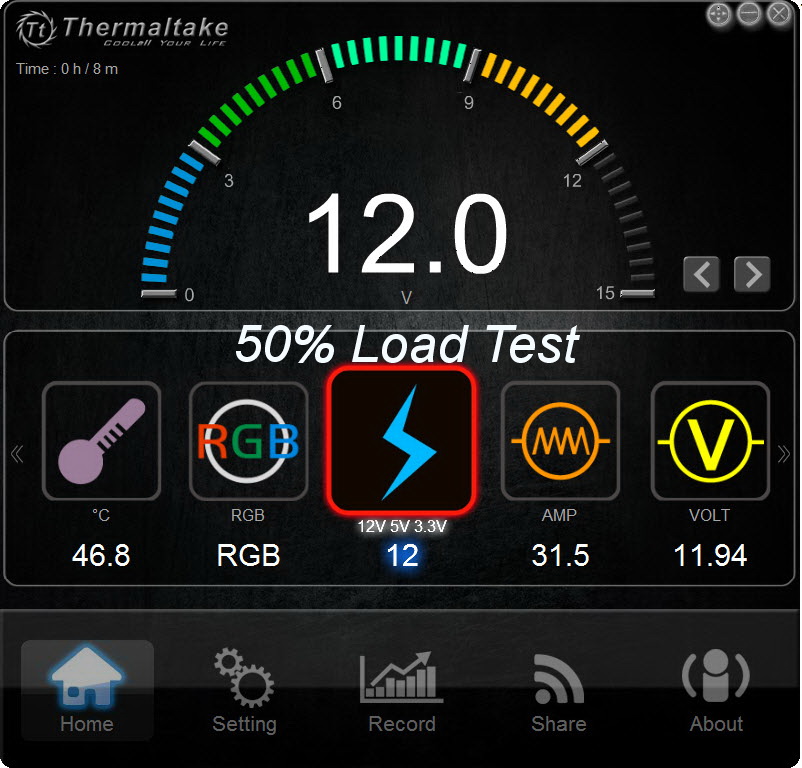







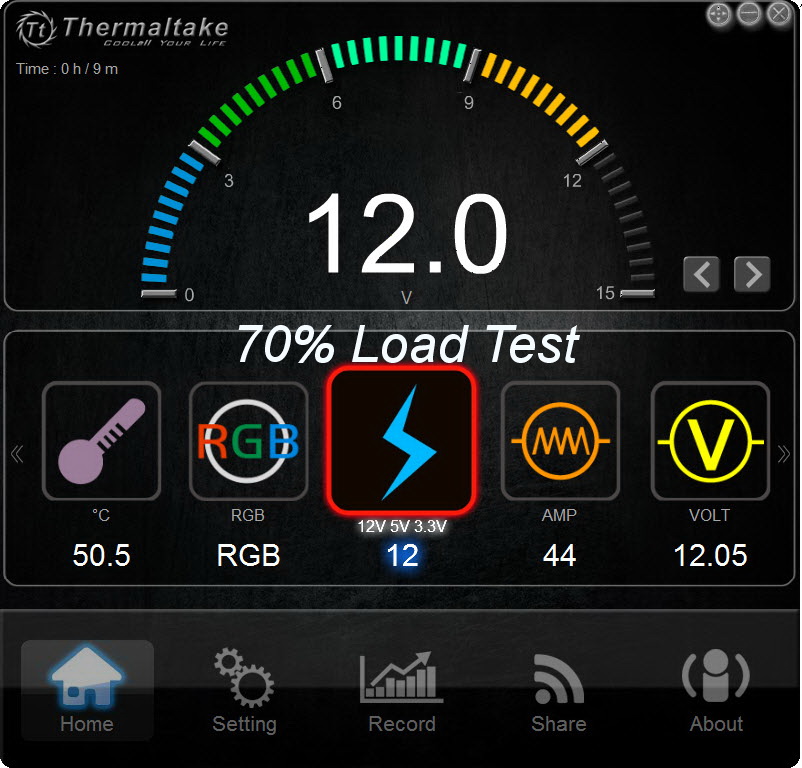







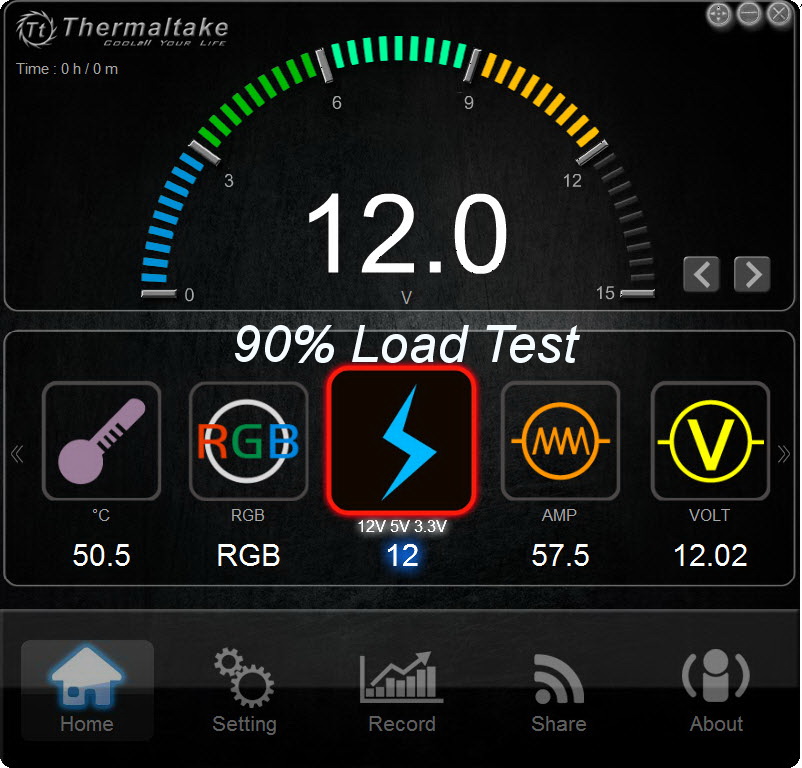
















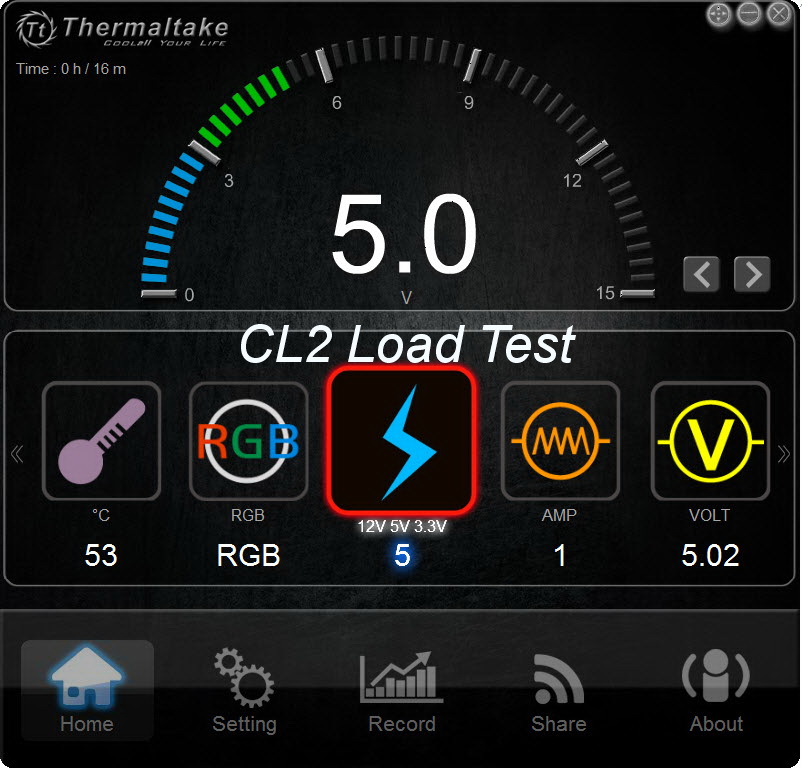


The provided efficiency readings aren't accurate enough; the same goes for the voltage readings, especially under high loads. On the other hand, the output wattage readings are quite accurate, so the problem looks to be in incoming power (the power that the PSU draws from the wall socket) measurements.
Current page: Load Regulation, Hold-Up Time, And Inrush Current
Prev Page A Look Inside And Component Analysis Next Page Efficiency, Temperature, And Noise
Aris Mpitziopoulos is a contributing editor at Tom's Hardware, covering PSUs.
-
powernod -It's not exactly a PSU-related question but more likely a general one.Reply
From the pictures from the monitoring software, i can notice that this software is able to measure CPU and GPU temperature. Do you have any idea if such monitoring is (relatively) accurate?
-Excellent review Aris !! -
Aris_Mp it takes readings from the system's (actually the individual components') sensors. If those are accurate then the software's readings will be accurate as well. Normally they are accurate.Reply -
Nuckles_56 That 12V transient response was certainly interesting, I don't think I've seen one do anything like that beforeReply -
turkey3_scratch Reply18886218 said:That 12V transient response was certainly interesting, I don't think I've seen one do anything like that before
Do what? -
Nuckles_56 Reply18886236 said:18886218 said:That 12V transient response was certainly interesting, I don't think I've seen one do anything like that before
Do what?
Go and plummet back down to almost 0V during the test -
turkey3_scratch Reply18887052 said:18886236 said:18886218 said:That 12V transient response was certainly interesting, I don't think I've seen one do anything like that before
Do what?
Go and plummet back down to almost 0V during the test
I don't think you're reading the transient response graph properly. It's not a measure of voltage but a measure of ripple (well, technically that is a measure of voltage but it's more a measure of instantaneous offsets of an average, or a highly zoomed in sector).
That or I am just missing something. I probably am. Not sure what I'm missing though. Forgive my ignorance. -
Nuckles_56 For this graph http://media.bestofmicro.com/ext/aHR0cDovL21lZGlhLmJlc3RvZm1pY3JvLmNvbS9TLzYvNjIxNzk4L29yaWdpbmFsLzEydl9vZmYuanBn/r_600x450.jpg I hope that I'm not reading it that badly wrongReply -
sparkyman215 Fantastic review Aris! I absolutely love reading in depth articles about anything. Terrible PSU for the price, but it's an awesome review. Congrats!Reply


